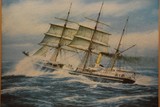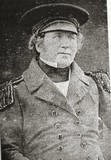- ALSA Home
- →
- Photo Gallery
- →
- Polar Vessels
- →
- View Item
JavaScript is disabled for your browser. Some features of this site may not work without it.
| dc.contributor.author | Cooper, J J | |
| dc.date.accessioned | 2021-01-29T06:42:55Z | |
| dc.date.available | 2021-01-29T06:42:55Z | |
| dc.date.created | 2015-03-26 | |
| dc.identifier.uri | http://hdl.handle.net/123456789/27588 | |
| dc.description.abstract | H.M.S. Erebus was a Hecla-class bomb vessel constructed by the Royal Navy in Pembroke Dockyard , Wales in 1826. After service in the Mediterranean Erebus was refitted as an exploration vessel for Antarctic service along with H.M.S. Terror, of the same class, but built earlier in 1812. The 1839 to 1843 Antarctic expedition was captained by Sir James Clark Ross and visited South Africa for three weeks in March-April 1840 on its way south. During this time a magnetic observatory was set up and Table Mountain was climbed. On 21 April 1840 the Erebus sailed along the southern coast of Marion Island, naming Cape Hooker after the ship's Assistant Surgeon and unofficial botanist, Joseph Dalton Hooker, as the island's (and South Africa's) most southerly point. The Terror under Commander Francis Crozier passed north of the island the next day, having become separated in bad weather while sailing from Simon’s Town. She noted Boot Rock, a prominent inshore feature named by the Challenger Expedition three decades later. The two ships called again at Simon’s Town on their way home in April 1843. Their successful expedition was one of the last voyages of exploration made entirely under sail. The sunken wreck of the Erebus was discovered in 2014 in the Arctic with its bronze bell being recovered. Canadian divers plan to explore the wreck further this year, with its exact locality being kept a secret. She and the Terror were lost along with the whole of Sir John Franklin’s Expedition in 1845. The final resting place of the Terror still remains to be found. The Bilas painting on board the S.A. Agulhas II depicts the Erebus and Terror in the Ross Sea, approaching the Ross Ice Shelf and Mount Erebus which the expedition discovered. Images includes HMS Erebus, Sir James Clark Ross and Commander Francis Crozier and Peter Bilas Painting | en_ZA |
| dc.description.sponsorship | Sponsored by the Department of Science and Innovation(DSI) through the National Research Foundation (South Africa) | en_ZA |
| dc.description.statementofresponsibility | Antarctic Legacy of South Africa | en_ZA |
| dc.language | English | en_ZA |
| dc.rights | Copyright | en_ZA |
| dc.subject | Transport - Sea - Ships | en_ZA |
| dc.title | H.M.S Erebus2015 | en_ZA |
| dc.type | Image | en_ZA |
| dc.rights.holder | Antarctic Legacy of South Africa | en_ZA |
| iso19115.mdconstraints.uselimitation | This item and the content of this website are subject to copyright protection. Reproduction of the content, or any part of it, other than for research, academic or non-commercial use is prohibited without prior consent from the copyright holder. | en_ZA |
| iso19115.mddistributor.distributorcontact | Antarctic legacy of South Africa | en_ZA |
| iso19115.mdformat.name | JPG | en_ZA |
| iso19115.mdidentification.deliverypoint | Antarctic Legacy of South Africa, Faculty of Science, Private Bag X1, Matieland. Stellenbosch. South Africa. | en_ZA |
| iso19115.mdidentification.electronicmailaddress | antarcticlegacy@sun.ac.za | en_ZA |
Files in this item
This item appears in the following Collection(s)
-
Polar Vessels [701]
Vessels in the Antarctic Region and Southern Ocean. Photo Gallery of Vessels used by South Africa for research and logistical purposes within the national Antarctic Programme. Also included are vessels that used South Africa as a Gateway to Antarctica




